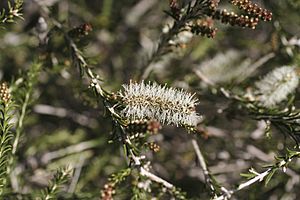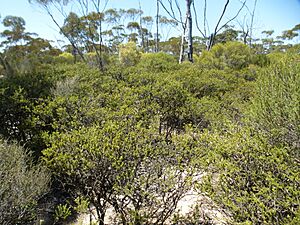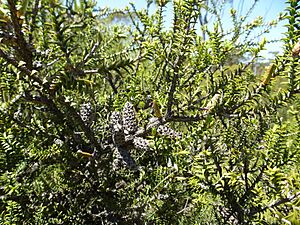Sandhill honey-myrtle facts for kids
Quick facts for kids Sandhill honey-myrtle |
|
|---|---|
 |
|
| Melaleuca adnata flowers near Kalbarri | |
| Scientific classification | |
| Genus: |
Melaleuca
|
| Species: |
adnata
|
The Sandhill Honey-Myrtle (Melaleuca adnata) is a special plant. It belongs to the myrtle family, called Myrtaceae. This plant grows only in the south-west part of Western Australia. It's a tall bush with bark that feels like paper. It also has spikes of white flowers that bloom in spring and early summer.
Contents
What Does It Look Like?
The Sandhill Honey-Myrtle is a shrub that can grow up to 6 meters (about 20 feet) tall. It has bark that looks and feels like paper or fibers. Its leaves are arranged in a unique way. They grow in pairs, with each pair at a right angle to the one above and below it. This makes the leaves form four neat rows along the stems.
The leaves are shaped like an oval or a narrow egg. They are about 4 to 12 millimeters (0.16 to 0.47 inches) long and 1 to 3 millimeters (0.04 to 0.12 inches) wide. If you cut a leaf in half, it would look like a crescent moon. The leaf stems (called petioles) are attached to the underside of the leaves.
Flowers and Fruits
The flowers of the Sandhill Honey-Myrtle are white or cream-colored. They grow in spikes on the sides of the branches. Each flower spike is about 15 millimeters (0.6 inches) wide. You can find between 8 and 50 individual flowers in one spike.
The petals of the flowers are small, about 1.7 to 2.1 millimeters long. They usually fall off once the flower opens. Inside the flower, there are five groups of stamens. Stamens are the parts of the flower that make pollen. Each group has 10 to 16 stamens.
This plant flowers from July to January. After the flowers, small woody fruits appear. These fruits are like capsules, about 2 to 3.3 millimeters (0.08 to 0.13 inches) long. They grow in clusters that look roughly like cylinders along the stems.
How It Got Its Name
The Sandhill Honey-Myrtle was first officially described in 1852. A scientist named Nikolai Turczaninow gave it the name Melaleuca adnata.
The second part of its scientific name, adnata, comes from a Latin word. "Adnatus" means "adnate," which describes how the leaves are attached to the stem.
Where Does It Grow?
You can find the Sandhill Honey-Myrtle in the south-west of Western Australia. It grows in areas like Kalbarri, Ongerup, and Mount Holland. It prefers sandy or clay soils. Sometimes, it grows over a type of hard soil called laterite. You can often spot it along natural water paths or on flat areas.
Conservation Status
The Government of Western Australia's Department of Parks and Wildlife says that this plant is "not threatened." This means it is not currently in danger of disappearing.



